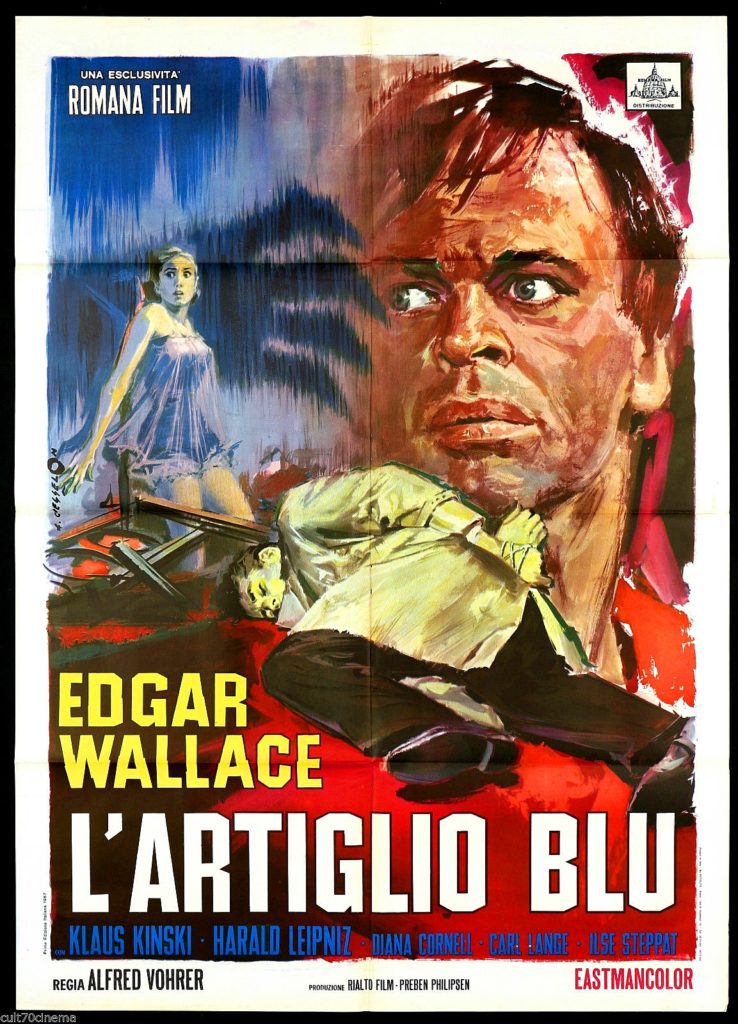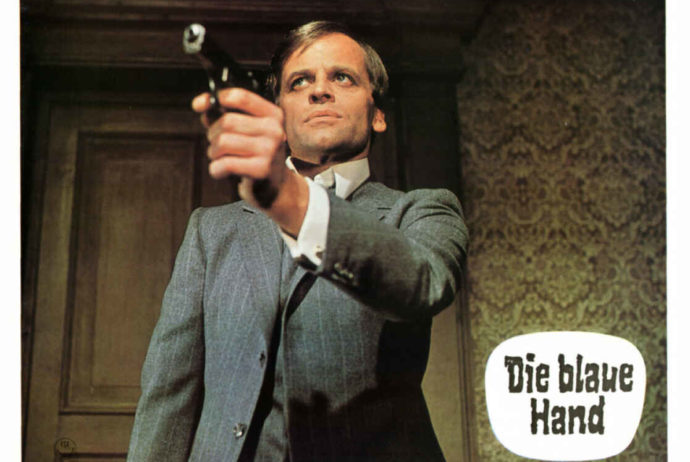Dir: Alfred Vohrer
Star: Harald Leipnitz, Carl Lange, Klaus Kinski, Ilse Steppat
a.k.a. Die Blaue Hand (original title) and The Bloody Dead
But, wait! There’s more! Order this film today and you’ll get not just one Klaus Kinski! You’ll also receive an additional Klaus Kinski (of equal or lesser value), absolutely free! Just pay separate postage and handling… That’s kinda what this feels like, since KK plays identical twin brothers, Dave and Richard Emerson. They are both sons of an English lord, the third Earl of Emerson, who vanished under dubious circumstances a while back after being caught embezzling money. Dave is convicted of murdering an estate gardener, but is found to be insane and committed, protesting his innocence loudly, to an asylum run by Dr. Mangrove (Lange, in a part which would fit Malcolm McDowell like a glove for a modern remake). With some anonymous help, Dave escapes, heads back to the family home and takes the place of Richard.
But it’s not long before dead bodies start piling up, courtesy of a cloaked figure wielding an ancestral bit of weaponry called the “Blue Hand” which looks like a medieval attempt at Wolverine cosplay. Enter Inspector Craig of Scotland Yard (Leipnitz), who has to try and unravel the convoluted goings-on, in which it appears just about everyone has a motive for murder. Mangrove, for example, has a shady side business committing people – especially those in line for inheritances – for cash, and Lady Emerson (Steppat, best known as Irma Bunt from On Her Majesty’s Secret Service) has a bit of a murky past herself, shown in the following exchange with Craig:
“You were born as Shenk, a former dancer, appearing in…”
“I know what I was appearing in!”
 I guess, in 1967, this was edgy stuff. Anyway, back in the impenetrable morass which is the plot, you’d better hold on with both hands, especially in the final 10 minutes when Craig pulls the solution out, with a flourish befitting a cabaret magician finding a rabbit in his top-hat, and about as much logic. Yes, I suppose the culprit could have committed the crimes as Craig alleges; but if I was their defense attorney, I’d be filing for a motion to dismiss based on a severe lack of evidence. It could have been just about anybody. My money’s on Mangrove, mostly because I tend to be suspicious of psychiatrists whose office has a painting, behind which is a hidden snake-cage, the inhabitant of which he uses, for example, to traumatize a nurse who has found out about his nefarious schemes.
I guess, in 1967, this was edgy stuff. Anyway, back in the impenetrable morass which is the plot, you’d better hold on with both hands, especially in the final 10 minutes when Craig pulls the solution out, with a flourish befitting a cabaret magician finding a rabbit in his top-hat, and about as much logic. Yes, I suppose the culprit could have committed the crimes as Craig alleges; but if I was their defense attorney, I’d be filing for a motion to dismiss based on a severe lack of evidence. It could have been just about anybody. My money’s on Mangrove, mostly because I tend to be suspicious of psychiatrists whose office has a painting, behind which is a hidden snake-cage, the inhabitant of which he uses, for example, to traumatize a nurse who has found out about his nefarious schemes.
To be honest, you have to admire his loopily inventive approach to psychiatry, which involves stockpiling problematic patients in the literal basement of the facility, sending the most psychotic inmate out on murder missions, and keeping an insane strip-tease dancer in another cell: according to the Doctor, “She takes [her clothes] on and off continuously. An occupational hazard I believe.” At another point, he locks another member of the Emerson family, Myrna, in a room with a glass case full of rats. Then a door slides open in the wall, revealing a chute down which tumble a knot of snakes, sending Myrna cowering over to the door. But then, a piston slides through the glass case, expelling the rodents into the reptiles? Wouldn’t that all-you-can-eat buffet actually distract the snakes from terrorizing Myrna? Seems Mangrove might not have thought this concept through too well…
It’s all rather Gothic in feel, Emerson Manor possessing a near-endless supply of secret doors, hidden passages and suits of armor, conveniently equipped with still lethal attachments. As noted, the potential suspects are no less numerous, even to the point where the film possesses an extremely suspicious butler, without even having the shame to wink at offering this most obvious of murderers (or most obvious of red herrings). It’s also more than a tad confusing: is that version of Kinski the one playing Dave? Dick? Dave pretending to be Dick? I’d like to have seen rather more of the unhinged Dave, because a character certified as a lunatic, yet one claiming to be entirely sane, is entirely in Kinski’s wheel-house. Instead, it’s not too long before he’s pretending to Dick, and relative normality has been restored, with his innocence also being established with such ease, it left me wondering why the West Memphis Three spent 18 years behind bars. Dave and Richard are both notable by their disappointing absence in the second half, when it becomes much more about Craig and his investigation of Mangrove.
20 years later, it was re-released as The Bloody Dead, with new footage – entirely unconnected to the original movie – intended to spice things up, for example, by adding gore to the murders. I’ve not seen that version (since it doesn’t include any additional Kinski, there didn’t seem much point!), but by all accounts, it’s a waste of time. For this version, as krimis go, this is certainly… one. It’s a genre often compared to the Italian giallo, and this example is perhaps the closest of the ones I’ve seen, particularly in its plot appearing to take a very distant second-place to atmosphere, particularly in terms of the final resolution. While somewhat more down-to-earth, in that there are no supernatural elements present here, it has its share of what my wife calls “I’m so sure…” moments. If the results are still entertaining enough, these make it difficult to become fully engaged with the story or its characters.
